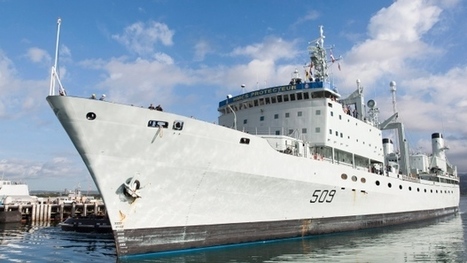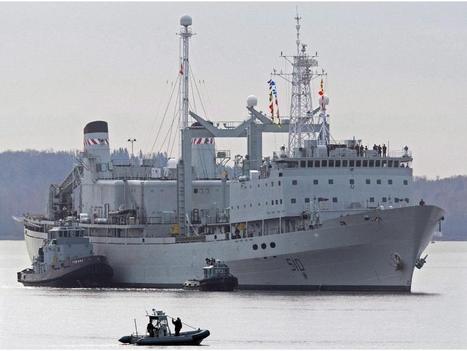The federal government is trimming its expected order of Arctic patrol ships and evaluating a set of unsolicited proposals to convert civilian cargo ships for use by the Royal Canadian Navy, The Canadian Press has learned.
Both steps are a sign that more modest expectations have been set for the government's national shipbuilding strategy, which has yet to deliver a single vessel some three years after the shipyards were chosen in 2011.
The navy is set to retire its two replenishment ships, HMCS Preserver and the fire-damaged HMCS Protecteur, without having any replacements ready to sail, despite a decade-long replacement program.
New joint support ships are only slated to begin construction in late 2016, with an in-service target of 2019-2020, but the government has yet to sign a construction deal with the designated shipyard, Seaspan of Vancouver.
Officials insisted last year that Canada could rely on its allies to refuel and rearm its warships in the meantime, but a series of government and defence sources say a newer proposal from the Quebec-based Davie Shipyard would provide beefed-up civilian ships under a five-year lease.
There is "growing interest" in the plan as a stopgap until the new supply ships arrive, said one defence source, speaking on condition of anonymity because the person was not authorized to speak to the media.
Questions involving price, timeline and the general viability of the proposal are still being explored, a second industry source confirmed.
At the same time, negotiations with Halifax-based Irving Shipbuilding for the construction of new Arctic offshore patrol ships have seen the government scale back its original plan to buy between six and eight of the vessels to enforce sovereignty in the North.
The new plan is to buy five light icebreakers, with an option for a sixth.
1 ship per yearSources also say the proposed contract calls for the delivery of only one ship per year because that's all the government can afford.
The deadline to sign a deal is the end of the year and there is intense political pressure to see "steel being cut" in time for next year's federal election.
The Arctic ships, a pet project of the Conservatives, have had their capabilities repeatedly watered down on the drawing board in order to keep costs down.
The original plan included three heavy military icebreakers; what is being proposed now is a ship that can cut through only one-year old ice and with limited armaments.
Phil Lagasse, a defence expert at the University of Ottawa, said the back-room maneuverings only confirm that money remains the biggest problem for the strategy and that the government is prepared to wait and accept fewer ships.
That could be bad news for communities like Halifax, which were counting on building everything the government promised.
"Politically, it was oversold. I think we can agree on that," said Lagasse, who added that the national shipbuilding procurement strategy, as it's known, was only intended to set up a framework for building ships in Canada.
"[The strategy] doesn't magically solve your planning problem. It doesn't solve your defence inflation problem. None of that is solved just because you successfully selected two yards."
Concern around leasingSahir Khan, a former official at the parliamentary budget office who studied the joint support ship program, said Canada — like its allies — has yet to be able to balance the kind of warships it wants and needs with the amount of money it's willing to spend.
"No matter how long we delay having such an open and transparent debate in Canada, it is highly unlikely that our path will diverge from that of our peers," said Khan, who is now at the University of Ottawa.
Both Khan and Lagasse expressed concern about a lease of temporary supply ships, saying the government may end up paying through the nose, depending upon how it's structured.
Eric Lerhe, a retired commodore, said the stopgap measure for the supply ships isn't a surprise because of the retirement of the existing vessels, which — although long past their shelf life — were not due to leave the service for another couple of years.
There were published reports Canada was considering a deal to acquire mothballed U.S. Navy replenishment ships. That plan was dismissed, partly because the American ships were costly to operate and required a crew complement twice that of the Canadian navy.
Producing only one Arctic ship a year is not a bad thing because it allows for a smooth introduction to service, said Lehre, who's now an adjunct professor at Dalhousie University in Halifax.



 Your new post is loading...
Your new post is loading...








